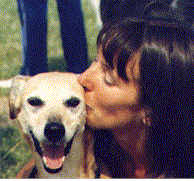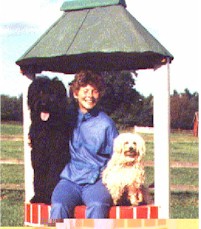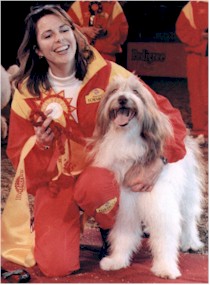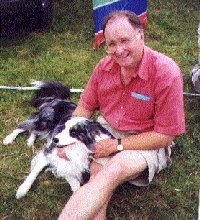| |
Don't forget, it's a team sport...
|
Your dog is your friend, your
partner, your defender.
You are his life, his love, his leader.
He will be yours, faithful and true, to the last beat of his heart.
You owe it to him to be worthy of such devotion.
Unknown |
 For many of us, one of the reasons we enjoy competitive canine sports so
much is due to this attachment we form with our dog(s). Reciprocally, to succeed in these
sports, one must start with a good, solid relationship with the dog. Kathy Herzog began this
article with the idea in mind of discussing forms of reinforcement and reward, and how these
concepts relate to agility training. However, as she began her research, she realised that an
exploration of one's relationship with one's dog is much more germane and basic to the ultimate
goal of having a cohesive and successful agility team. For many of us, one of the reasons we enjoy competitive canine sports so
much is due to this attachment we form with our dog(s). Reciprocally, to succeed in these
sports, one must start with a good, solid relationship with the dog. Kathy Herzog began this
article with the idea in mind of discussing forms of reinforcement and reward, and how these
concepts relate to agility training. However, as she began her research, she realised that an
exploration of one's relationship with one's dog is much more germane and basic to the ultimate
goal of having a cohesive and successful agility team.
The
deep and lasting bond that develops between humans and dogs is a fascinating phenomenon that
has been researched and written about extensively. This bond is unique: different from Man's
relationship with almost any other animal. You can't exactly have your horse or bird snuggle on
the bed with you.
Understanding how dogs learn, and understanding the bond between you and your
dog are very closely linked topics. Janet Lewis (1997) states, 'dogs that are trained by
handlers who do not try to understand how their companions learn will never be able to quite
master the rules of the game (p.10).' Similarly, the mutual trust and respect you help engender
with your dog is key to later training.
 Three Steps to Training
Three Steps to Training
There are some basic building blocks to training any behaviour in your dog. We will use
the example of teaching your dog to sit to illustrate these steps.
- First of all, one must create the desired behaviour, or cause it to
happen. You might food lure your dog into a sitting position, and then reward this behaviour.
- Second, you need to define the behaviour, so the dog understands what he
is asked to do. When the dog sits, you say 'good sit', and reward.
- Thirdly, you cue and reinforce the desired behaviour: 'sit'... and reward.
Finally, you maintain the behaviour: ask the dog to sit at different times,
in different places, etc. (Lewis, 1997).
 While these steps are basic, it is important to have a conscious understanding of them as you
teach your dog new things, and reinforce previously learned behaviours. Patti Hatfield, in her
wonderful agility seminars with Stuart Mah, stresses that one should always take advantage of
any training opportunity to reward one's dog. Yes, uninterrupted rounds are exciting, but the
dog does not learn half so much as when you take your time to reward and reinforce throughout
the running of the course. Even with an experienced dog, go back to basics often e.g. rewarding
for the perfect completion of one obstacle, and don't ever fade out food completely from one's
training sessions.
While these steps are basic, it is important to have a conscious understanding of them as you
teach your dog new things, and reinforce previously learned behaviours. Patti Hatfield, in her
wonderful agility seminars with Stuart Mah, stresses that one should always take advantage of
any training opportunity to reward one's dog. Yes, uninterrupted rounds are exciting, but the
dog does not learn half so much as when you take your time to reward and reinforce throughout
the running of the course. Even with an experienced dog, go back to basics often e.g. rewarding
for the perfect completion of one obstacle, and don't ever fade out food completely from one's
training sessions.
Partnership
Hand in hand with this process, and hopefully starting as soon as you bring your dog
home, you want to focus on the quality of the relationship you are building with your dog.
Sheila Booth (1998) stresses that while you are the master, or leader of the pack, your dog is
not a slave, but a willing partner in your activities together. She urges all dog owners to be
worthy of their canine companions. 'The more you put in the more you get back... always keep
your heart open to what your dog tries to give back. In the end, love will get you further than
luck (p. 346).' Ultimately, it doesn't matter if you practice agility six times a week, or once
a month. Your dog doesn't care about titles, ribbons, or trophies. He just wants to be with
you.

Agility is a very fun way to spend time together, but don't under-estimate
the power of merely hanging out, or playing games like tug, etc. You may be surprised that as
you become more mindful of your relationship with your canine friend, your performance in the
agility ring will improve.
References
- Sheila Booth (1998). Purely Positive Training: Companion to Competition
Podium Publishing, Ridgefield, Connecticut (USA)
- Janet Lewis (1997), Smart Trainers/Brilliant Dogs.
Canine Sport Productions, Lutherville, Maryland (USA)
Kathy Herzog, a clinical psychologist by day,
lives in south-eastern Massachusetts (USA). She was born in England (Cambridge) and has a
sister who lives in Oxford so she visits frequently. Although she grew up in America, she has
entertained thoughts of returning here to live, but the quarantine laws put her off since she
has three Pembroke Welsh Corgis. In addition to Agility, she shows Keri, her Corgi bitch.
Agility therapy: Do you find that people don't
understand your relationship with your dog. Do their eye's glaze over when you start talking
about agility at a party? Help is at hand. There's a worldwide audience out there waiting to
hear your true stories or see your pictures of your best friend. You can share that special
feeling that you have with dog with others of the same disposition by sending it to:-
Agilitynet.com
| |
|